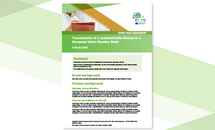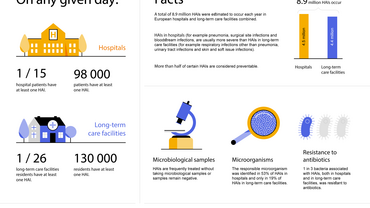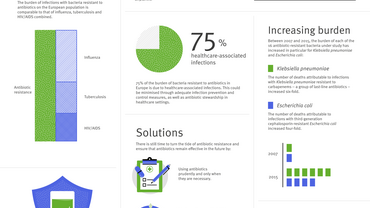Outbreak of carbapenemase-producing (NDM-1 and OXA-48) and colistin-resistant Klebsiella pneumoniae ST307, north-east Germany, 2019
Germany has reported an outbreak of carbapenemase-producing (NDM-1 and OXA-48) and colistin-resistant Klebsiella pneumoniae sequence type (ST) 307. As of 21 October 2019, 17 patients in three hospitals and one rehabilitation clinic in Mecklenburg-West Pomerania in north-east Germany have been affected. Six of the 17 cases presented with clinical symptoms of infection, while 11 were identified as be carriers.
Executive Summary
Germany has reported an outbreak of carbapenemase-producing (NDM-1 and OXA-48) and colistin-resistant Klebsiella pneumoniae sequence type (ST) 307. As of 21 October 2019, 17 patients in three hospitals and one rehabilitation clinic in Mecklenburg-West Pomerania in north-east Germany have been affected. Six of the 17 cases presented with clinical symptoms of infection, while 11 were identified as be carriers.
This is the first reported outbreak in Germany of K. pneumoniae that produce both NDM-1 and OXA-48 while also involving the emerging clone ST307. The outbreak strain is closely related to a K. pneumoniae ST307 isolate producing the same carbapenemases detected earlier in Finland from a patient previously hospitalised in Russia, yet there is no epidemiological link between the Finnish case and the outbreak in Germany.
K. pneumoniae ST307 is a high-risk clone expanding globally, including in the EU/EEA. The specific German outbreak strain carries virulence markers associated with increased ability to cause disease. Genetic characteristics related to a potential survival advantage in the environment have also been described for K. pneumoniae ST307. The combination of extensive antimicrobial resistance, increased virulence and capacity to persist in the environment result in a high risk for dissemination and future healthcare-associated outbreaks of this K. pneumoniae ST307 outbreak strain in hospitals and other healthcare settings. By contrast, the risk of transmission for individuals outside healthcare settings is low. Enhanced control measures have been implemented in the involved German hospitals, and no further cases have been detected since the end of September 2019.
The highly virulent and resistant K. pneumoniae strain of this outbreak was introduced to the EU/EEA in at least two countries in 2019: Germany and in Finland. As not all EU/EEA countries have an effective screening system for carbapenemase-producing Enterobacteriaceae (CPE) in high-risk patients and may also lack the capacity to perform whole genome sequencing (WGS) – or do not routinely employ WGS on all carbapenem-resistant K. pneumoniae isolates collected at the national level – the number of such imported events may be considerably underestimated. In addition, several other high-risk clones of carbapenemase-producing K. pneumoniae have been spreading in hospitals and other healthcare settings in the EU/EEA in recent years. Hospital admissions of patients with previous hospitalisations, including prior hospitalisation in another country, are a daily occurrence in the EU/EEA, and the risk for further introduction of such high-risk clones of K. pneumoniae to hospitals in the EU/EEA, possibly resulting in other hospital outbreaks, is therefore high.
This outbreak also highlights the concomitant increase in virulence, transmissibility and antimicrobial resistance among certain K. pneumoniae strains, which are posing a considerably higher risk to human health than has previously been the case with the broader K. pneumoniae population. Early detection of such strains and close cooperation between clinicians and public health services are crucial to avoid spread into the EU patient population. There is a need for increased capacity in the EU/EEA to support outbreak investigations and surveillance with real-time WGS to identify high-risk clones and to implement enhanced control measures in order to avoid further spread.








